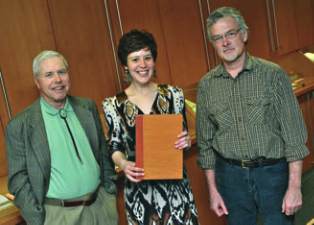Basic HTML Version


ON CAMPUS
6 SPRING 2012 | ST. LAWRENCE UNIVERSITY MAGAZINE
Shakespearean
Resource Center
Sarah Barber, a visiting assistant profes-
sor of English, holds a limited edition
copy of
Shakespeare’s Ovid
, published
by the De La More Press, London,
in 1904. The book, of which only
250 were made, is a reprint of Arthur
Golding’s 1567 translation of Ovid’s
The Metamorphoses
, said to be one of
William Shakespeare’s sourcebooks. It
was purchased at Barber’s request by
the Friends of the Owen D. Young and
Launders Libraries (FODYLL) for use
in her course on Shakespeare. Presenting
the book are, left, Albert Glover, Piskor
professor of English emeritus and board
chair of FODYLL, and Mark McMur-
ray, special collections librarian.
Mediation Center Offers
Conflict Resolution Help
A joint effort by student life, the peace
studies program and the chaplain’s of-
fice, the St. Lawrence Mediation Center
is a new resource for conflict resolution
that serves students, faculty and staff.
University Chaplain Kathleen Buckley
says that only a few small liberal arts
colleges have similar programs. “As a
culture, we struggle with how to work
through conflict in a healthy way,” she
says. “This is an opportunity for us to
develop those skills.”
Buckley adds that although they want
to help, most people try to avoid deal-
ing with conflict. “Therefore, we offer
conflict resolution through facilitated
conversations whenever anyone is in
conflict on campus,” says Associate Pro-
fessor of Philosophy and Coordinator of
Peace Studies Laura Rediehs.
Teeth, Dead Chickens
and Chewing Gum
What do these have in common?
They’re the props for recent teaching
and research on campus.
Sinking eir Teeth It
Don’t say you’d give your eye teeth for
anything when you’re around Visiting
Assistant Professor of Anthropology
Mindy Pitre. She might take you up on
the offer.
To assist students in her biological
anthropology courses, Pitre asked area
dentists to donate extracted teeth, and
they came through. The teeth have
joined the department’s teaching col-
lection, where they help students learn
tooth identification, which, Pitre says, is
“useful in careers in forensics, osteol-
ogy and the medical sciences” includ-
ing dentistry, and in understanding of
periodontal diseases.
at's a Wrap
In another “hands-on” learning exercise,
students in Pitre’s course Dealing with
the Dead learned how to mummify
chickens the old Egyptian way. This
required plunging their hands into the
carcasses to remove the organs (pictured).
Student reaction varied; one said the
exercise was “different and memorable,”
while several told a local newspaper re-
porter they wouldn’t be having chicken
for dinner that night. But, no one
chickened out.
Chew on is
Meanwhile, over in psychology,
Assistant Professor Serge Onyper has
demonstrated that students who have
an important exam coming up might
be wise to chew gum during test prep.
His study showed that students who did
so for five minutes before taking a test
scored better than non-chewers. But
not if they chewed during the test.
In other words, you can't chew gum
and think productively at the same time
after all.
Early to Bed…
Onyper was the lead researcher on an-
other study, showing that students who
take classes starting later in the morning
get more sleep, but also tend to abuse
alcohol more, because they feel they
have more time to go out with friends,
and wind up with lower grade-point
averages than their early-bird classmates.
His co-researcher and psychology col-
league Pamela Thacher authored a 2007
study showing that students who pull
"all-nighters" also get lower grades.
Memo to student readers out there: If
you want to get good grades, sign up
for early classes, skip the all-nighters
and chew some gum for a few minutes
before that big test. —MD

